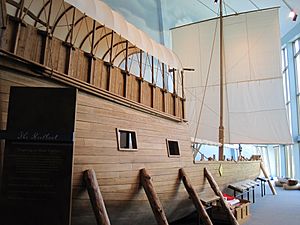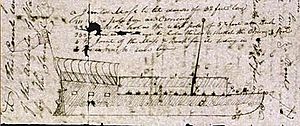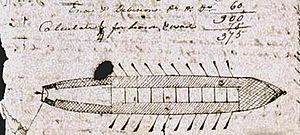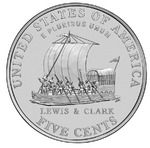Lewis and Clark's keelboat facts for kids
class="infobox " style="float: right; clear: right; width: 315px; border-spacing: 2px; text-align: left; font-size: 90%;" |+Lewis and Clark's keelboat
| colspan="2" style="text-align: center; font-size: 90%; line-height: 1.5em;" |
|}
The Lewis and Clark keelboat was a special boat built in Pittsburgh in 1803. It was made for the famous Lewis and Clark Expedition. Meriwether Lewis himself gave very detailed instructions for how it should be built. This type of boat, called a galley, could move in many ways. It could be pushed by oars, powered by sails, or moved with long poles and towlines. The keelboat was the main boat for the expedition until the spring of 1805. At that point, it was sent back to St. Louis.
Contents
- Journey of the Keelboat
- How the Keelboat Was Designed
- Building the Keelboat
- How the Keelboat Moved
- The Keelboat Crew
Journey of the Keelboat
In May 1803, Meriwether Lewis ordered a riverboat to be built in Pittsburgh. He had very specific ideas for its design. When Lewis arrived in Pittsburgh, he found that the boat builder had only just started working on it. This made Lewis worried because he wanted to begin the journey before the Ohio River's water level got too low in the summer. He also wanted to reach the Mississippi River before it froze in the fall.
Lewis finally set sail from Pittsburgh with the boat on August 31, 1803. After meeting up with William Clark, the expedition officially started from Clarksville, Indiana, on October 26. They had the main keelboat and two smaller boats called pirogues. About two weeks later, they arrived at Fort Massac. On November 28, they reached Fort Kaskaskia, which was about 50 miles south of St. Louis.
The expedition spent the winter at Camp Dubois. This was a temporary camp on the Illinois side of the Mississippi River, right across from where the Missouri River flows into it. On May 14, 1804, the team left Camp Dubois and began their journey up the Missouri River. The river's strong current made them move very slowly, sometimes only one mile per hour. They finally reached the Mandan villages in what is now North Dakota on October 26. This was after traveling about 1,500 miles from Camp Dubois. The expedition built a new camp called Fort Mandan and stayed there for the winter.
The keelboat was sent back to St. Louis on April 6, 1805, with some members of the expedition who were returning home. The rest of the expedition continued their journey overland to the Pacific Ocean. The trip downstream for the keelboat took only 43 days. The boat arrived safely in St. Louis with all the important diaries and scientific samples still in good condition, even though there were spring floods. It is believed that the boat was later sold to someone who offered the most money.
How the Keelboat Was Designed
William Clarkmade two drawings of the keelboat in his diary; this one shows the side view.
Meriwether Lewis designed the keelboat himself. He watched over its construction and probably made changes as it was being built. The boat was like a galley, which was a common type of boat used on rivers in the eastern United States. However, it was very unusual for rivers west of the Appalachian Mountains.
The keelboat was 55 feet long and 8 feet wide. It had a shallow bottom, which meant it didn't need very deep water to float. The mast, which held the sails, was 32 feet tall and could be lowered. The boat could use a small front sail (called a headsail) and a large square sail. There was a 10-foot-long deck at the front, which was like a small raised area called a forecastle. A similar raised area at the back, called an aftercastle, held a small cabin. The main storage area, called the hold, could carry up to 12 tons of supplies. In front of the aftercastle, there were 11 benches for the oarsmen.
Building the Keelboat
Clark's drawing of the keelboat from above.
Lewis was not happy with how slowly the boat was being built. The boat builder was very slow and had arguments with his workers, which caused some of them to quit. This made the building process even slower. The builder promised to work faster, but he only kept his promise for about a week. Lewis had to spend most of his time at the boat yard in Pittsburgh to try and speed things up. In his diary, Lewis never wrote down the name of the boat builder. For a long time, historians have tried to figure out who he was. Many clues suggest it was Jacob Myers, an older man who had experience building boats and owning galleys.
How the Keelboat Moved
This memorial nickel shows how setting poles were used on Lewis & Clark's Keelboat.
The keelboat could be moved in several ways. It could be propelled by oars, sails, long poles, and towlines. When using the setting poles, the crew would place the poles on the river bottom and push off. They would walk from the front of the boat to the back to gain momentum. Towlines were ropes used to pull the boat. Men, horses, or even oxen would walk along the riverbank and pull the boat forward.
The Keelboat Crew
The expedition had clear rules about who should be on the keelboat. One of the main leaders, either Lewis or Clark, always had to be on the keelboat as the commander. One sergeant was in charge of steering the boat (the helmsman). Another sergeant was in the middle of the boat (amidships), and a third sergeant was at the very front (the bow).
The helmsman was responsible for steering the boat. He also made sure the cargo on deck was secure and was in charge of the compass. The sergeant in the middle of the boat commanded the armed guards and managed the sails. He also supervised the oarsmen and reported any new river outlets, islands, or interesting sights they passed. He was also responsible for giving out the whisky ration and was on duty at night. The bowsman, at the front, acted as a lookout. He reported any other boats on the river or any Native American camps they saw.
Two private soldiers, Labiche and Cruzatte, had special permanent jobs on the boat. They were chosen because they were very experienced boatmen. One of them always worked the oar on the left side of the boat (the larboard bow oar), while the other helped the bowsman.
| History | |
|---|---|
| Builder | Jacob Myers of Pittsburgh, designed by Meriwether Lewis |
| Launched | 1803 |
| General characteristics | |
| Type | Galley |
| Tonnage | 12 t (12,000 kg) |
| Length | 55 feet (17 m) |
| Beam | 100 inches (250 cm) |
| Height | 32 feet at mast |
| Draft | 3 feet |
| Propulsion | Square rigged mainsail, headsail, 20 oars |
| Sail plan | 1 mast |
| Capacity | 666 |
| Crew | 1 captain as commander, 1 sergeant as helmsman, 1 sergeant as centerman, 1 sergeant and 1 private as bowsmen, 22 privates as oarmen |
| Armament | 1 swivel gun and 2 blunderbusses |





